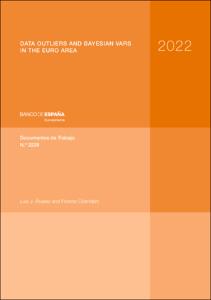Data outliers and Bayesian VARs in the euro area
Autor
Fecha de publicación
14-nov-2022
Descripción física
37 p.
Resumen
Este trabajo propone un método para ajustar los datos atípicos en modelos vectoriales autorregresivos estimados con técnicas bayesianas (BVAR) que supone reescalar por magnitudes diferentes la varianza de los errores de la forma reducida. Se utiliza este método para documentar varios hechos sobre el efecto de los valores atípicos en la estimación y la previsión fuera de muestra utilizando datos macroeconómicos de la zona del euro. En primer lugar, la pandemia de COVID-19 provocó grandes oscilaciones en los datos macroeconómicos que distorsionan los resultados de estimación de los modelos BVAR. En segundo lugar, estas oscilaciones pueden abordarse reescalando la varianza de las perturbaciones. En tercer lugar, si se tienen en cuenta los valores atípicos antes de 2020, se obtienen ligeras mejoras en las previsiones puntuales de los BVAR para algunas variables y horizontes. Sin embargo, el rendimiento de las previsiones de las densidades se deteriora considerablemente. Por lo tanto, recomendamos tener en cuenta los valores atípicos solo en las fechas preestablecidas en torno al inicio de la pandemia de COVID-19.
We propose a method to adjust for data outliers in Bayesian Vector Autoregressions (BVARs), which allows for different outlier magnitudes across variables and rescales the reduced form error terms. We use the method to document several facts about the effect of outliers on estimation and out-of-sample forecasting results using euro area macroeconomic data. First, the COVID-19 pandemic led to large swings in macroeconomic data that distort the BVAR estimation results. Second, these swings can be addressed by rescaling the shocks’ variance. Third, taking into account outliers before 2020 leads to mild improvements in the point forecasts of BVARs for some variables and horizons. However, the density forecast performance considerably deteriorates. Therefore, we recommend taking into account outliers only on pre-specified dates around the onset of the COVID-19 pandemic.
We propose a method to adjust for data outliers in Bayesian Vector Autoregressions (BVARs), which allows for different outlier magnitudes across variables and rescales the reduced form error terms. We use the method to document several facts about the effect of outliers on estimation and out-of-sample forecasting results using euro area macroeconomic data. First, the COVID-19 pandemic led to large swings in macroeconomic data that distort the BVAR estimation results. Second, these swings can be addressed by rescaling the shocks’ variance. Third, taking into account outliers before 2020 leads to mild improvements in the point forecasts of BVARs for some variables and horizons. However, the density forecast performance considerably deteriorates. Therefore, we recommend taking into account outliers only on pre-specified dates around the onset of the COVID-19 pandemic.
Publicado en
Documentos de Trabajo / Banco de España, 2239
Materias
Pandemia de COVID-19; Valores atípicos; BVAR; Predicción; Área del euro; COVID-19 pandemic; Outliers; Bayesian VARs; Forecasting; Euro area; Fluctuaciones y ciclos económicos; Modelización econométrica; Métodos Econométricos y Estadísticos; Modelos econométricos; Zona euro
Aparece en las colecciones:












